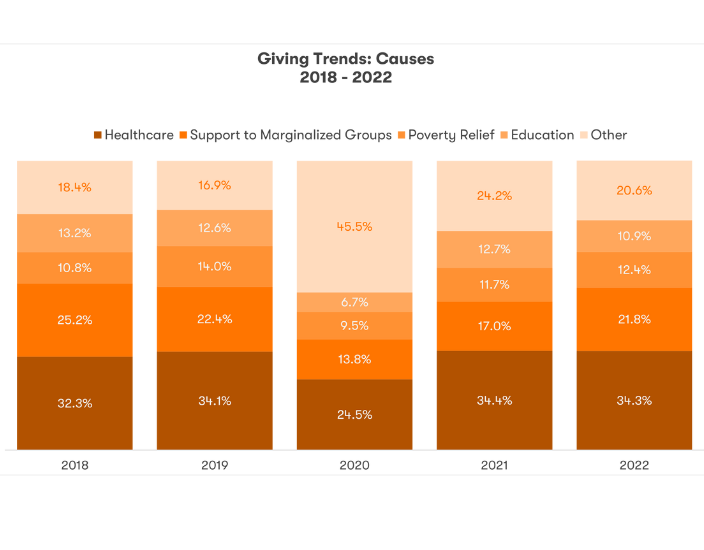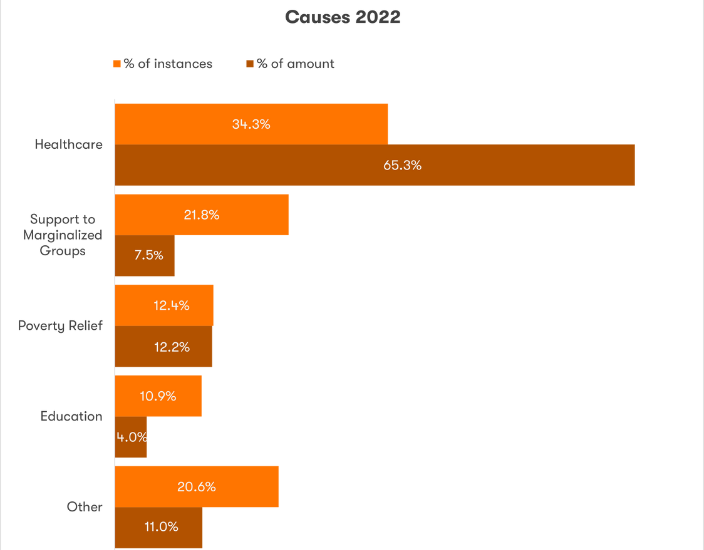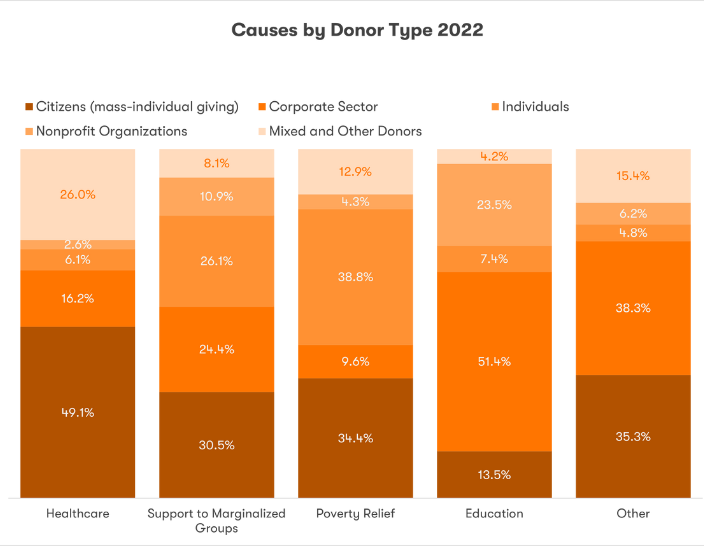In 2022, healthcare remained the primary cause of giving in Serbia, as it was in the previous year. Giving for healthcare accounted for more than one-third of all donation instances and approximately two-thirds of the total amount. Donations intended for providing medical treatments were the most common form of support for healthcare, following the trend observed in previous years. Several nonprofit organizations played a crucial role in raising funds for medical treatments, which often required substantial sums.
Regarding changes in the distribution of giving across key causes, the most significant increase was observed in support for marginalized groups. This rise can be attributed to a greater number of initiatives targeting people in economic need for providing social services, children without parental care, and single-parent families. As for other prominent causes, there was a slight decrease in support for education in 2022, while giving towards poverty relief remained relatively on a similar level.

Graph 1. Trends in Causes of Giving 2018 – 2022 (% instances)
Healthcare has been the most supported cause of giving in Serbia since 2018, with the exception of 2020 when donations aimed to mitigate the effects of COVID-19. The proportion of instances dedicated to healthcare typically hovered around one-third of total giving. Support for marginalized groups constituted 21.8% of donation instances and 7.5% of the donated amount, making it the second most prevalent cause for giving. Other key areas received a smaller share, with poverty relief accounting for 12.4% of instances and education generating 10.9%.
Less supported causes collectively represented 20.6% of donation instances, a lower percentage compared to 2021. Seasonal giving accounted for 8.3% of all instances, followed by environment (2.6%), culture and arts (1.6%), sports (1.3%), and economic development (1.1%). Causes outside these categories had a share of less than 1% of instances. In the distribution of the total donated amount for other causes, religious activities, seasonal giving, and emergency management stood out - with around 1.3%. According to the Giving Balkans database, during the previous year more than 402,600 euros were donated for the support of people affected by the war in Ukraine.

Graph 2. Distribution of Giving in Serbia in 2022 by Cause
Causes by Types of Donors
Citizens through mass-individual giving were the primary donor type for healthcare and support to marginalized groups. Individuals displayed high levels of activity as donors for poverty relief, whereas corporate donors took the lead in contributing to education-related causes.

Graph 3. Causes of Giving by Donor Type (% of all instances)
Causes by Intended Effects of Giving
Donations with intended short-term effects were prevalent across all key cause areas, except for education. In the giving for healthcare, 79.6% of donation instances were aimed at providing short-term effects, primarily medical treatments. Similarly, for poverty relief, 94.7% of all donations had short-term intended effects, often including humanitarian support.
Conversely, donations with long-term effects were most prevalent in the field of education. This aligns with the common practice of strategic giving for education, which often involves the provision of equipment and scholarships to support long-term educational opportunities.

Graph 4. Causes of Giving by Intended Effect (% instances)
Examples of Giving
Support to Healthcare
Galenika, a company committed to healthcare, donated 80,000 euros to the Institute for Cardiovascular Diseases Dedinje. The contribution funded a video endoscopy tower, transforming heart valve disorder surgeries. Patients benefit from increased surgeries and reduced operation durations.
Support to Education
Telekom Srbija launched "Creating Knowledge," gifting vital IT equipment to 20 schools. A joint effort with the Ministry of Education identified 40 needy schools, with five chosen from each region. Public participation ensured transparent school selection.
Social Entrepreneurship
"Zadrugarstvo" Association's campaign raised 9,000 euros on Donacije.rs. The goal was establishing a recycling and paper workshop in Kragujevac for adults with disabilities. The initiative fosters an inclusive setting, providing training and ongoing support.
Another action comes from Women's Center Užice, which initiated the "Support the Women of Retex Center" campaign. Employing six women, including five with disabilities, they recycle used textiles, assisting 280 underprivileged families. A sustainable approach benefiting both women and the environment.
Developers for Citizens action
Vega IT's "Developers for Citizens" earned the prestigious VIRTUS Award. The program created 15 software solutions for nonprofit organizations. Ideas were community-voted, and IT companies collaborated, showcasing their commitment to philanthropy.
The Annual report Giving Serbia 2022 was supported by the C. S. Mott Foundation and the Rockefeller Brothers Fund. The views expressed on this web page do not necessarily reflect the views of the C. S . Mott Foundation and the Rockefeller Brothers Fund and their partners.


Leave a comment